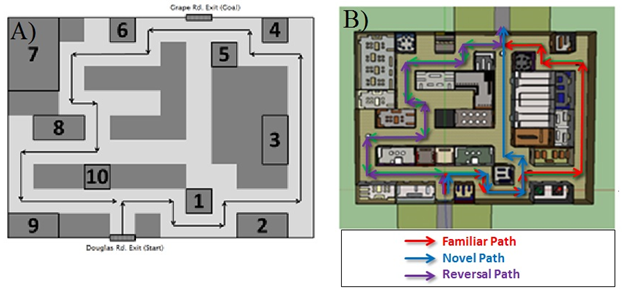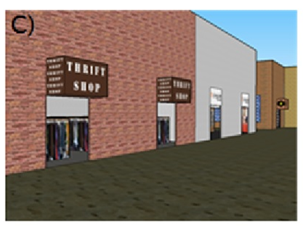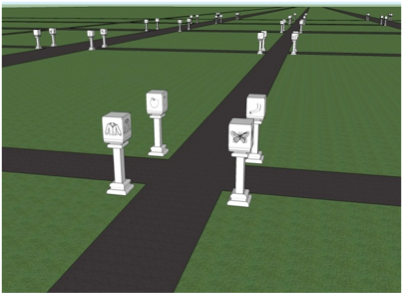Our framework for understanding navigation in buildings:
 Carlson, L. A., Hölscher, C., Shipley, T. F., & Conroy Dalton, R. (2010). Getting Lost in Buildings. Current Directions in Psychological Science, 19(5), 284-289.
Carlson, L. A., Hölscher, C., Shipley, T. F., & Conroy Dalton, R. (2010). Getting Lost in Buildings. Current Directions in Psychological Science, 19(5), 284-289.
Using this framework, the Carlson lab is investigating how features of an environment, individual differences in ability and strategy, and an individual’s mental representation of an environment interact when navigating.
Stress and Navigation
This line of research examines the effects of stress and an individual’s spatial ability, measured as mental rotation ability, on navigation during an emergency situation – a fire in a mall. Participants learn a virtual mall environment and were subsequently either told to meet a friend at the far exit (control) or to use the far exit to escape a fire.
 In an emergency, participants were faster to start moving, made more errors during navigation, and overestimated the amount of time they took to exit relative to controls. Relative to controls, low spatial participants in an emergency more often reversed a learned path to exit the mall, whereas high spatial participants more often directly used a previously learned path. These results illustrate that stress from an emergency situation negatively impacts navigation, and that the behavioral consequences of this are in part dependent upon one’s spatial abilities. Follow-up research is currently ongoing to further understand these differences in solution use.
In an emergency, participants were faster to start moving, made more errors during navigation, and overestimated the amount of time they took to exit relative to controls. Relative to controls, low spatial participants in an emergency more often reversed a learned path to exit the mall, whereas high spatial participants more often directly used a previously learned path. These results illustrate that stress from an emergency situation negatively impacts navigation, and that the behavioral consequences of this are in part dependent upon one’s spatial abilities. Follow-up research is currently ongoing to further understand these differences in solution use.
Landmarks at Intersections
Landmarks at intersections are better remembered and are more likely to be included in maps and descriptions of environments. However, most often, there are multiple landmarks at any given intersection, and it is unclear what defines landmark selection in these cases. This work examines the features that define landmark selection when multiple landmarks are at a given intersection. In particular, we are interested in disentangling the roles of spatial and perceptual features in landmark selection.


